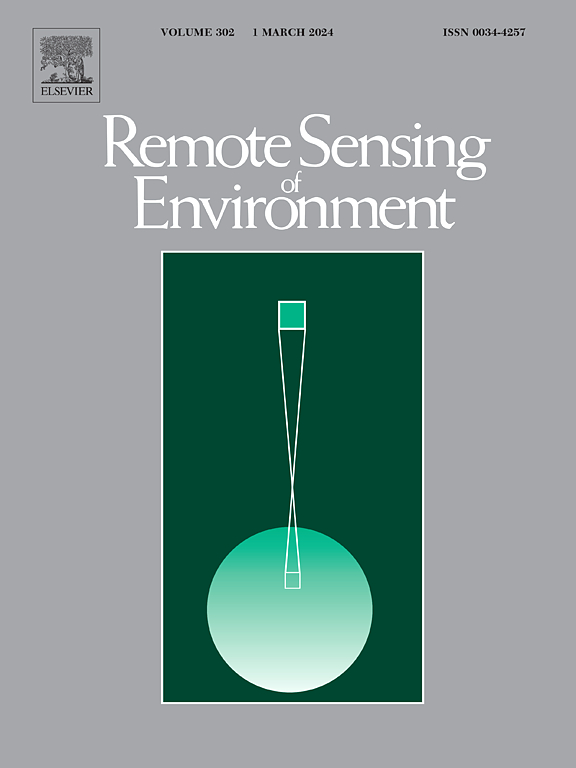Coordinated estimates of 4-day 500 m global land surface energy balance components
IF 11.1
1区 地球科学
Q1 ENVIRONMENTAL SCIENCES
引用次数: 0
Abstract
Accurate estimations of global land surface energy balance components [including net radiation (Rn), latent heat flux (LE), soil heat flux (G) and sensible heat flux (H)] are crucial for quantifying the exchange of heat and water between the land surface and atmosphere. In this study, a novel and practical model for Coordinated estimates of 4-day 500 m global land Surface Energy Balance components (CoSEB) was developed, using the multivariate random forest technique and a synthesis of remote sensing and reanalysis datasets, as well as the extensive observations at 336 eddy-covariance sites worldwide. The CoSEB model effectively balances the estimates of Rn, LE, H, and G by learning the physics of energy conservation embedded in these components within the training datasets. Its advantages include 1) the accurate estimation of the four energy components and their ratios [i.e. evaporation fraction, defined as , which reflects the proportion of surface available energy that is allocated to LE instead of H], and 2) the ability to maintain energy balance among the four energy components, i.e. . With the 10-fold cross-validation at 286 sites, the CoSEB model achieved the root mean square error (RMSE) of 16.42 W/m2, 16.40 W/m2, 16.49 W/m2, 4.79 W/m2 and 0.22, and the coefficient of determination (R2) of 0.92, 0.86, 0.83, 0.55 and 0.59, respectively, for estimating Rn, LE, H, G and evaporative fraction, which were comparable or superior to those estimated by other typical data-driven uncoordinated and coordinated models. In the validation with test datasets at another 50 eddy-covariance sites, the CoSEB model, with the RMSE of 18.23 W/m2, 17.98 W/m2, and 19.17 W/m2, and the R2 of 0.87, 0.72, 0.71 in estimating Rn, LE, and H, respectively, outperformed all six state-of-the-art algorithms/products, i.e. FLUXCOM, BESSV2.0, MOD16A2, PML_V2, ETMonitor and GLASS. Besides, the CoSEB model successfully maintained energy balance, exhibiting an energy imbalance ratio [EIR, defined as ] of 0, in comparison to other coordinated and uncoordinated models/products presenting the EIRs of as high as 50%. The new model also produced consistent global patterns with the six state-of-the-art products for each of the Rn, LE, and H estimates at 8-day, monthly, and yearly scales. The CoSEB model is promising for operationally generating high-accuracy global balanced land surface energy components and their ratios, which is essential for rationally partitioning surface available energy into H and LE, and for revealing the spatiotemporal variations of the energy components and their attributions and mechanisms at regional and global scales.
4天500米全球陆地表面能量平衡分量的协调估计
准确估算全球地表能量平衡分量[包括净辐射(Rn)、潜热通量(LE)、土壤热通量(G)和感热通量(H)]对于量化地表与大气之间的热和水交换至关重要。本文利用多变量随机森林技术,综合遥感和再分析数据集,以及全球336个涡旋协方差站点的大量观测数据,建立了一个新的、实用的4天500 m全球陆地表面能量平衡分量(CoSEB)协调估计模型。CoSEB模型通过学习嵌入在训练数据集中这些组件中的节能物理,有效地平衡了Rn、LE、H和G的估计。它的优点包括:1)准确估计四种能量分量及其比值[即蒸发分数,定义为LE/Rn−G,它反映了分配给LE而不是H的表面可用能量的比例];2)能够保持四种能量分量之间的能量平衡,即Rn−G−LE−H=0。通过对286个站点的10倍交叉验证,CoSEB模型估算的Rn、LE、H、G和蒸发分数的均方根误差(RMSE)分别为16.42、16.40、16.49、4.79和0.22,决定系数(R2)分别为0.92、0.86、0.83、0.55和0.59,与其他典型数据驱动的非协调和协调模型估算的结果相当或优于。在另外50个涡流协方差点的测试数据集验证中,CoSEB模型在估计Rn、LE和H方面的RMSE分别为18.23、17.98和19.17 W/m2, R2分别为0.87、0.72和0.71,优于FLUXCOM、BESSV2.0、MOD16A2、PML_V2、ETMonitor和GLASS这6种最先进的算法/产品。此外,CoSEB模型成功地保持了能量平衡,其能量不平衡比[EIR,定义为100%×Rn−G−LE−H/Rn]为0,而其他协调和非协调模型/产品的EIR高达50%。新模型还使用六种最先进的产品,在8天、每月和每年的尺度上对每个Rn、LE和H进行估计,产生一致的全球模式。CoSEB模式可在实际操作中生成高精度的全球平衡地表能量分量及其比值,为合理划分地表可利用能量为H和LE,揭示能量分量在区域和全球尺度上的时空变化特征及其归因和机制提供依据。
本文章由计算机程序翻译,如有差异,请以英文原文为准。
求助全文
约1分钟内获得全文
求助全文
来源期刊

Remote Sensing of Environment
环境科学-成像科学与照相技术
CiteScore
25.10
自引率
8.90%
发文量
455
审稿时长
53 days
期刊介绍:
Remote Sensing of Environment (RSE) serves the Earth observation community by disseminating results on the theory, science, applications, and technology that contribute to advancing the field of remote sensing. With a thoroughly interdisciplinary approach, RSE encompasses terrestrial, oceanic, and atmospheric sensing.
The journal emphasizes biophysical and quantitative approaches to remote sensing at local to global scales, covering a diverse range of applications and techniques.
RSE serves as a vital platform for the exchange of knowledge and advancements in the dynamic field of remote sensing.
 求助内容:
求助内容: 应助结果提醒方式:
应助结果提醒方式:


